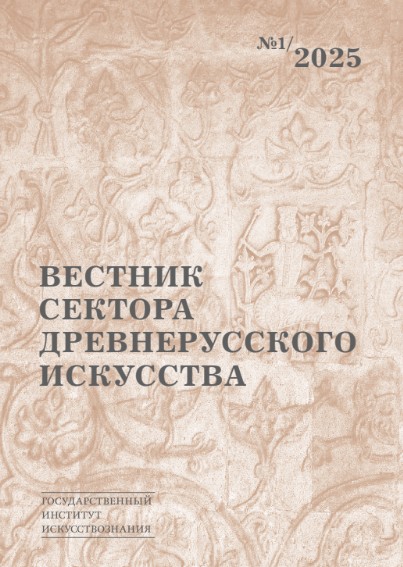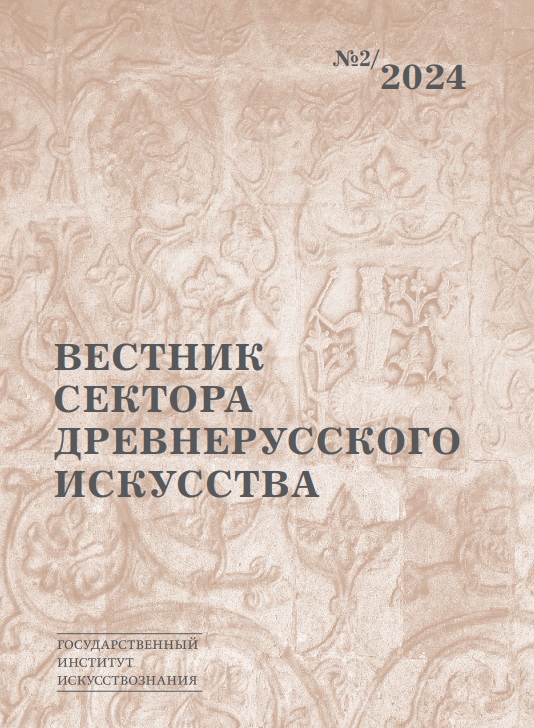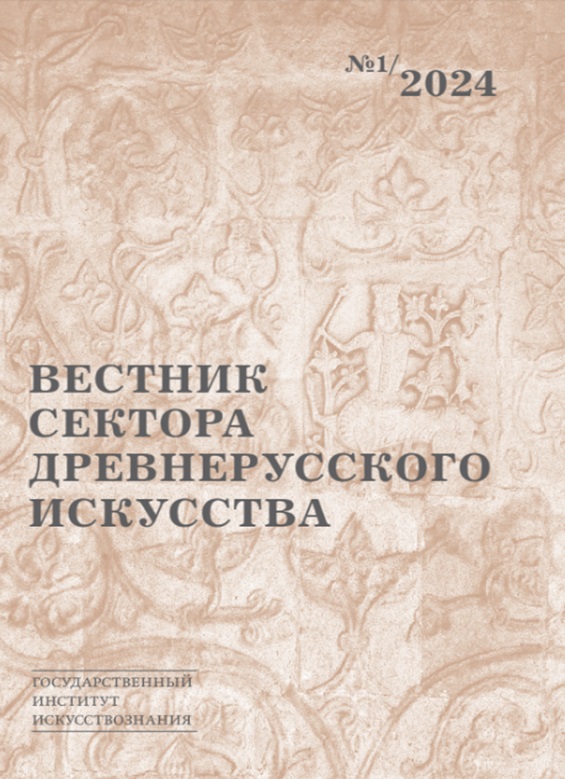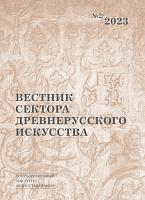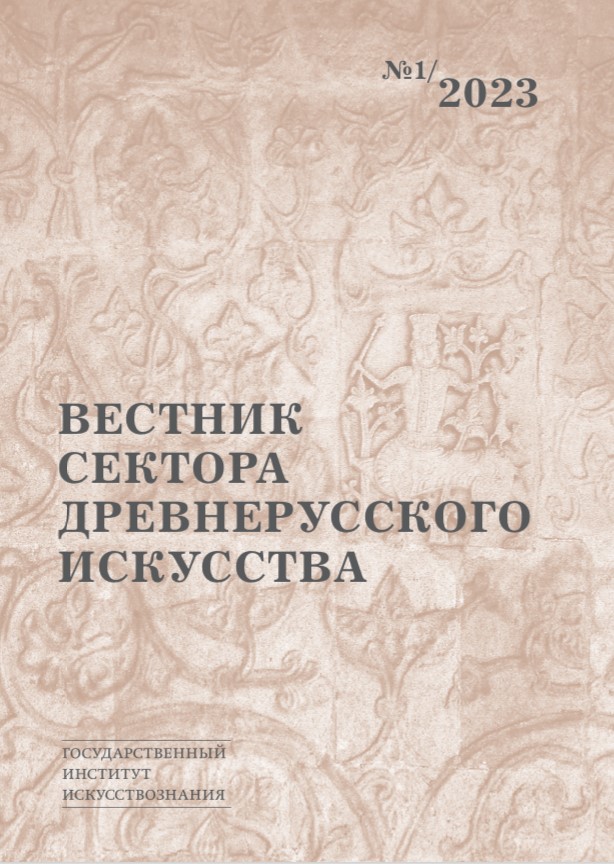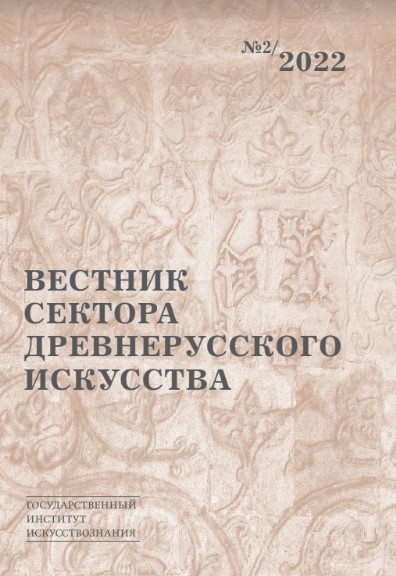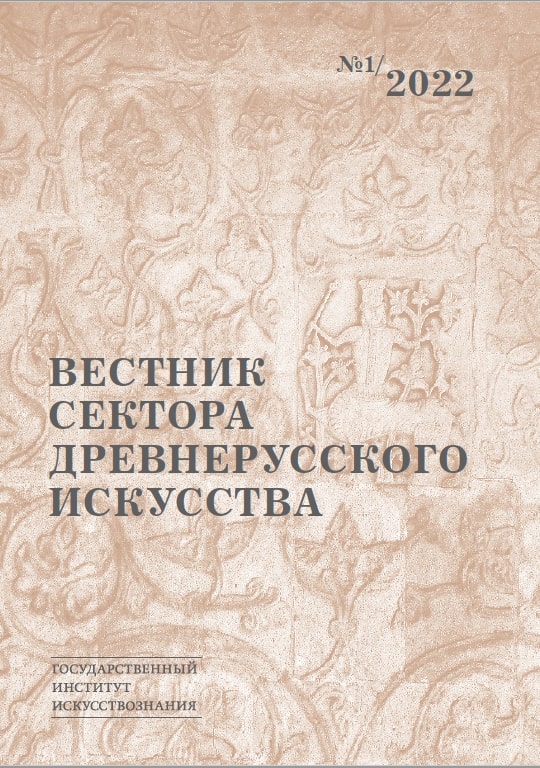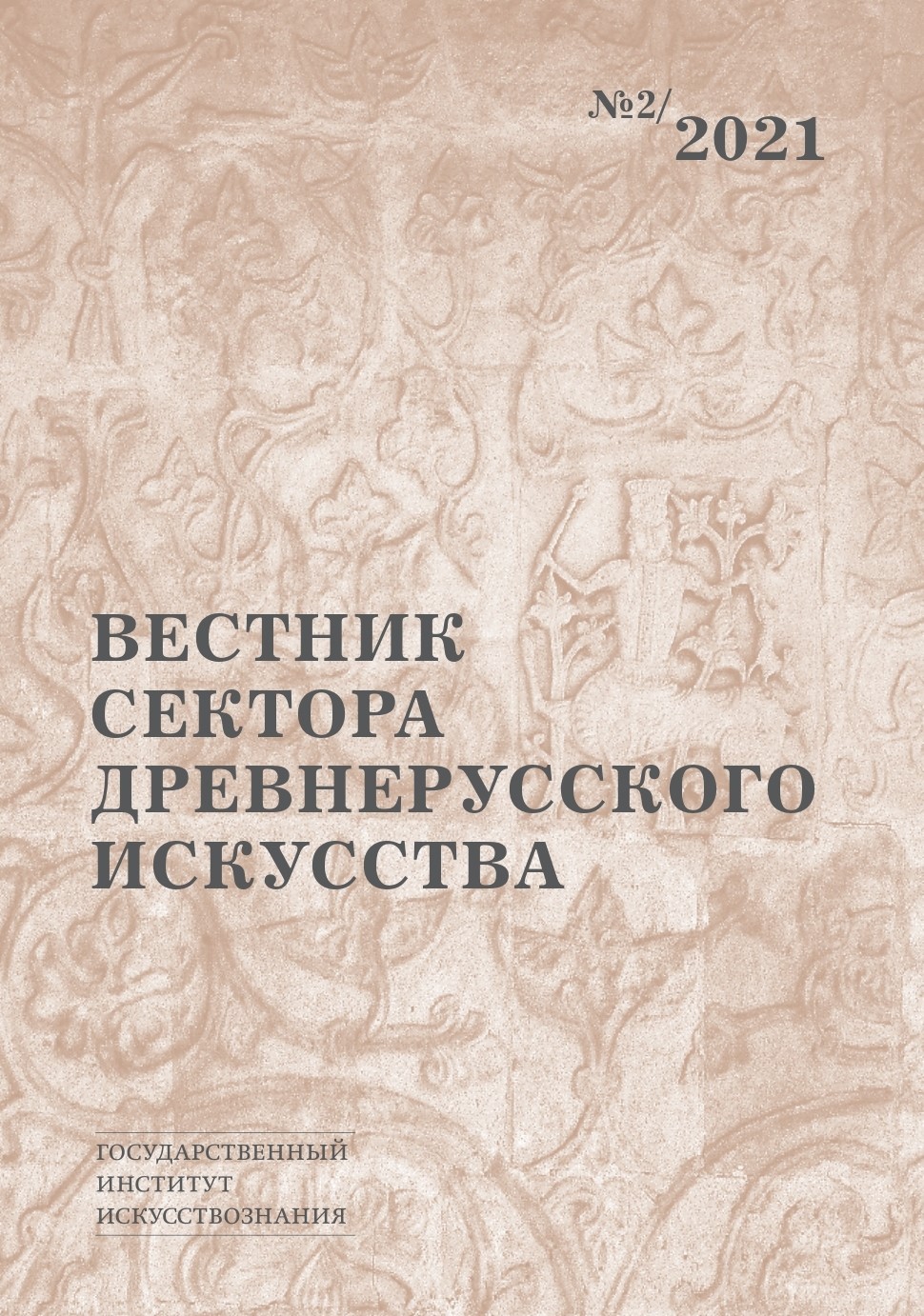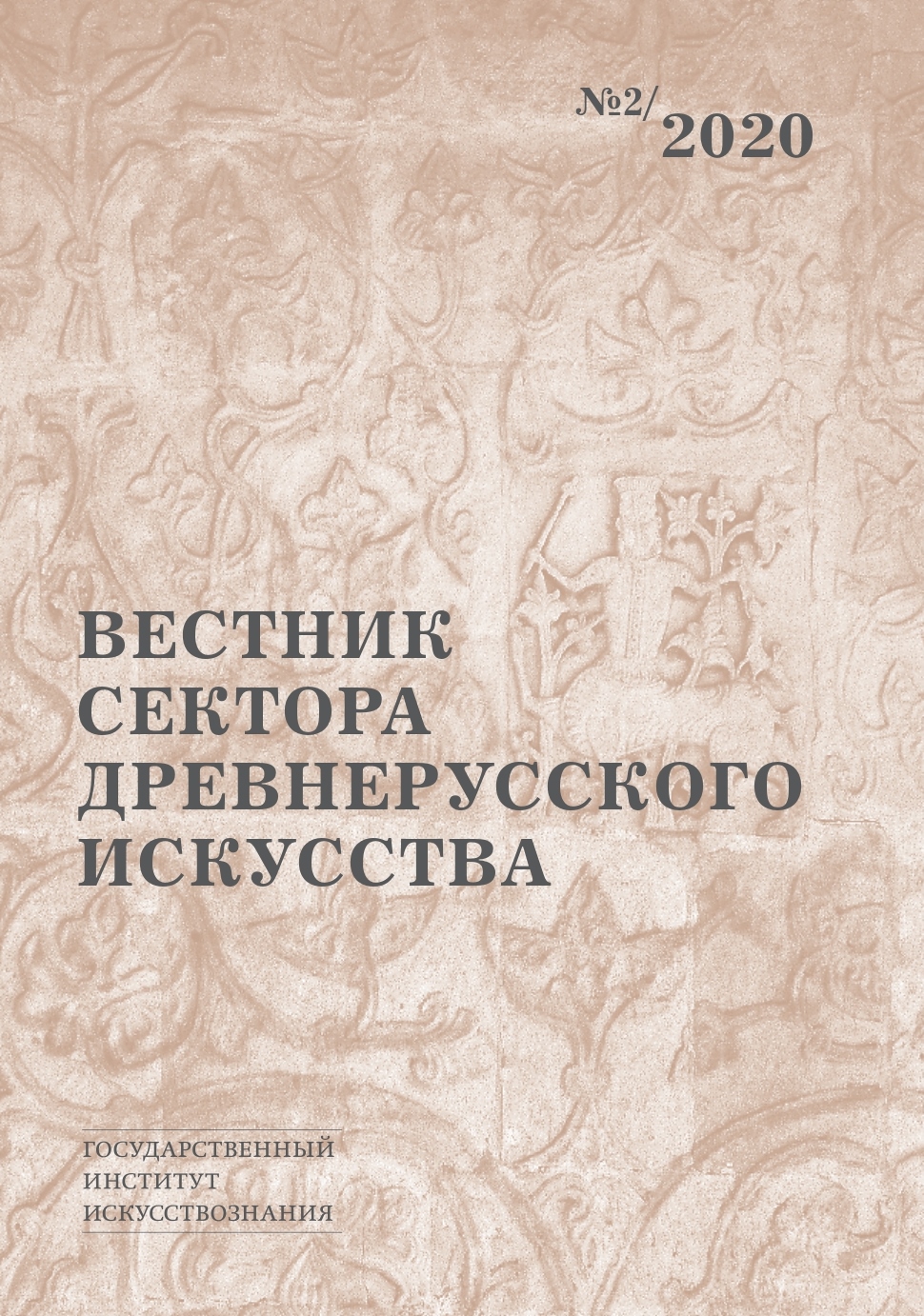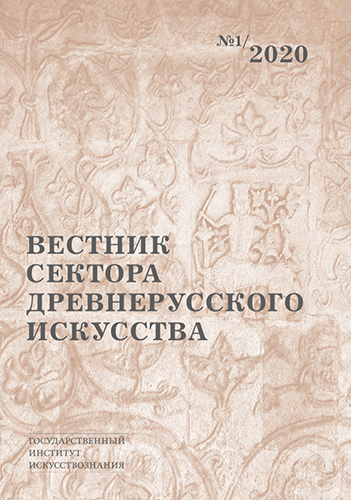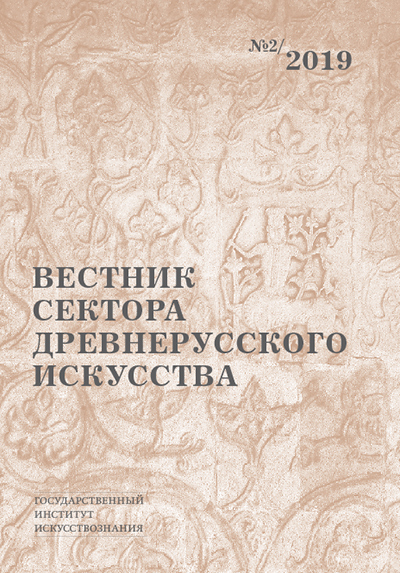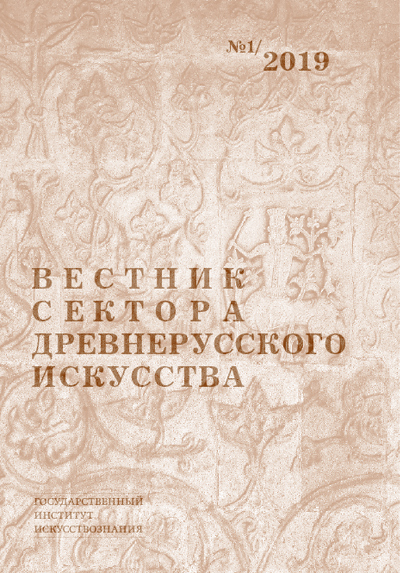2021 № 2
ARTICLES
Ekaterina Gladysheva. Icon “Our Lady of Vladimir” of the First Third of the 12th Century: the Relation of Images on the Front and Back Sides. Recent Restoration Research and Iconographic Analogies
Abstract
The article analyses the results of technical and technological research of the Constantinople icon “Our Lady of Vladimir” of the first third of the 12th century, which were carried out in the Tretyakov Gallery in 2006–2016 by a group of specialists led by the restorer D.Sukhoverkov. As a result of these studies an image, overpainted by the composition “The Throne and the Instruments of the Passion” by a Moscow artist in the 1410s, was discovered on the reverse of the icon. The original image is a half portrait of St. Nicholas of Myra, judging by the iconographic features. This image, lost as far back as the first half of the 13th century, can be reconstructed from the nail marks of a lost metal cover on the basis of X-ray images made in different ways. Iconographic analogies, in which the Mother of God and the Child in the “Tenderness” type are correlated with the figures of the church fathers, including St. Nicholas, prove that such a comparison changes the meaning of the Mother of God image. If initially such icons have been formed and perceived as images of passions, afterwards, thanks to visual parallels with the images of saints, the theme of protection and prayer for mercy on the human race comes to the fore. A study of historical sources suggests that the commissioner of the future Vladimir Icon in Constantinople was the Kiev prince Mstislav Vladimirovich (1125–1132), who intended to place it in one of the Mother of God temples in Vyshgorod, a city that was one of the centers of the St. Nicholas cult in Russia. It can be assumed that it was by the order of Mstislav that the two revered images of the Byzantine capital—the Mother of God and the Child, and St. Nicholas— were combined in one icon.
Keywords
Miraculous images, double-sided icon, technical and technological research, iconographic program, cycle of miniatures.
Daria Skobtsova. Once Again On the Dating of the Frescoes in the Main Space of the Church of Our Saviour in Polotsk
Abstract
The article is devoted to the problem of dating the main complex of fresco paintings of the Transfiguration Church of St. Euphrosyne Convent in Polotsk, which was erected in the 12th century. The date of the monument's creation is still debated and this paper attempts to find a solution based on the stylistic features of the frescoes. Comparing the Polotsk mural with the painting of the 1120s–1190s allows us to attribute it to the middle of the 12th century (circa 1161).
Keywords
Miraculous images, double-sided icon, technical and technological research, iconographic program, cycle of miniatures.
Aleksandr Musin. The So-called “Chapel of Saint Joachim and Anna” in Kyiv’s Saint Sophia Cathedral: a Short Historical Guide
Abstract
The article critically revises the modern research methodology of iconographic programs of churches in Early Rus’. The author refutes the hypothesis of the existence of the chapel dedicated to Sts. Joachim and Anna, which appears only in the 18th century, in the 11th century Saint Sophia Cathedral in Kyiv. The article emphasizes the absence of a stable position of the Marian cycle in the decoration system of byzantine churches in the 11th century. The author suggests that the prothesis in the Kyiv Saint Sophia Cathedral was originally performed in the southern apse of the main altar, which may be indicated by the frescoes of Sts. Joachim and Anna’s story.
Keywords
Saint Sophia Cathedral in Kyiv, Cappadocia, Saint Sophia in Ochrid, Dafni, iconographic program, research methodology, Marian cycle, lateral chapels, prothesis.
Alexei Gippius, Svetlana Laschuk. Inscriptions on Vasilyevsky Gates, 1336
Abstract
The article presents a consolidated catalog of inscriptions on the Novgorod gates of 1336, which includes texts read for the first time and previously unpublished. In addition to the inscriptions themselves, the catalog provides explanations for the readings of controversial places, as well as notes on the orthography and the sources of the inscriptions. For hard-toread inscriptions, such as the complex of texts in the composition “Weighing of a soul” and the inscription in the plate “Kitovras and Solomon”, a coherent interpretation is offered for the first time. The transcription and translation for the prayer on the door strip are specified, which allows a more complete description of the literary technique of its author archbishop Vasily Kalika.
Keywords
Epigraphy, Vasilievsky gates, inscriptions on the church doors, Novgorod writing, archbishop Vasily Kalika.
Leonid Beliaev. Catholicon and Cemetery. Vysoko-Petrovsky Monastery (Moscow): Finds, Losses, Methodological Errors of the 2010s. Part Two
Abstract
The paper presents the second half of the article about the problems of dating architectural structures by methods of archeology and epigraphy. The article publishes and analyzes the tombstones of the 16th century, discovered in 2016 during the works around the Cathedral of Peter the Metropolitan in the Vysoko-Petrovsky Monastery (Moscow). The inscriptions on the gravestones made it possible to clarify the date when the construction of the cathedral began (no later than the summer of 1512). This required proving the existence of secondary tombstones— repetitions, replicas, bearing the same texts as the original stones. The characteristics of the 16th century slabs and the reading of their inscriptions are given.
Keywords
Late medieval archaeology, history of architecture, chronology, methods of the research and restoration, cemetery, tombstones, epigraphy.
Vladimir Kiprin, Vladislav Riabov, Olga Kim. Church of the Conception of St. John the Baptist on Volkhonka. New Information and a Study in Reconstruction
Abstract
The article presents new archival data on the Moscow parish church, the Church of the Conception of John the Baptist on the Lenivy Torzhok, dismantled at the end of the 18th century. On the basis of some newly identified text and graphic documents, including a drawing of the façade of the church in 1792, it was possible to carry out an architectural reconstruction of the church, which belonged to the circle of monuments of the Naryshkin style.
Keywords
Moscow, history of architecture, church, Naryshkin style, architectural reconstruction, archival documents.
Liudmila Vorontsova. Saints on the Margins of the Icon “Our Lady of Hodegetria” “Prayers of Sergius the Miracle Worker”
Abstract
The icon “Our Lady of Odigitria” from the Sergiev Posad Museum-Reserve collection, according to the monastery legend, was a personal “cell” icon of the founder of the Trinity-Sergius Monastery, St. Sergius of Radonezh. On the side and bottom margins of the icon there are images of three saints whose names were identified in different ways over the time. The revered icon has been renovated and refurbished several times over the centuries. During one of the repairs, the images in the margins were either overpainted or significantly updated. The article examines the iconographic features and composition of images in the margins of the icon in certain historical periods.
Keywords
Icon, Our Lady of Hodegetria, Sergius of Radonezh, Trinity-Sergius Lavra, added saints, iconography.
Svetlana Baranova, Raniya Raimova. On the Origin of the Tiled Decoration of the Peter and Paul Cathedral in Kazan
Abstract
The article deals with the tile decoration of the Peter and Paul Cathedral in Kazan (1726) for the first time. The decoration of the church shows a technique of façade ornamentation, typical for the second half of the 17th century. In the first third of the 18th century a lot of provincial capitals, including Kazan, were set with buildings which combined Old Russian, Moscow and European elements. Due to the lack of documents we are forced to turn to the array of archaeological finds, made mainly on the territory of the Kazan Kremlin, as well as in the house of a merchant I.A.Mikhlyaev, the founder of the cathedral. Studying and comparing the tile groups with Moscow, Nizhny Novgorod and Balakhna analogues we were able to conclude that the ready-made items were purchased in Balakhna, one of the largest centres of tilemaking in Russia. It is reflected in the design (ornamentation, colour) and structure elements (rumpa) of the tiles of the Cathedral.
Keywords
Peter the Great, Peter and Paul Cathedral, Kazan, tiled décor, tiles purchasing, Balachna, archeological finds.
Irina Kyzlasova. Alexander Ivanovich Anisimov: Under the Cover of the Angel
Abstract
The article is the first publication of a wonderful portrait of the outstanding historian of the Byzantine and Old Russian art A.I.Anisimov (1877–1937), arrested on October 6, 1930, sent to the camp at Solovki and shot there. The drawing dates back to 1930. The artist D.N.Yakunin (1891–1977) did not miss the very last opportunity to capture his friend: the guardian angel as the last defender is depicted over his head. The article provides a description of the iconography of A.I.Anisimov. For the first time the main milestones of the biography of D.N.Yakunin, a talented artist born in a peasant family, were reconstructed from the documents. Perhaps the article will serve as an incentive to search for a large oil portrait of A.I.Anisimov, made by the same artist.
Keywords
Alexander Anisimov, Victor Lazarev, the biography of the artist Dmitry Iakunin, earlier unknown graphic portrait.
Tatiana Samoilova. Icons from an Unknown Uglich Iconostasis. The Problem of Dating
Abstract
Five deesis icons from Uglich in the collection of the Tretyakov Gallery have attracted our attention due to the high quality of their painting. In the 1963 catalog by V.I.Antonova and N.E.Mneva they were dated by the end of the 15th century. The attribution was based on the assumption, which has not been confirmed in any way, that they originate from the Transfiguration Cathedral in Uglich. The article makes an attempt of stylistic and iconographic analysis of the Uglich icons in order to clarify the dating without reference to a hypothetical origin. This research allows us to propose a different dating and to state a hypothesis that the Uglich Deesis was created in the first decade of the 16th century or not later than 1516, and to include these icons into the artistic circle of the post-Dionysian epoch.
Keywords
Deesis, icons, iconography, stylistic analysis, post-Dionysian era, Dionysius art time, Uglich principality, Grand Prince Vasily III
Chronicles
Restoration chronicles
Polina Tychinskaia, Vladimir Kalashnikov, Iulia Sycheva, Maria Makarova. Restoration Chronicles. May—December 2021Exhibitions
Lilia Lepshina. The Exhibition Glory to Thy Name! in Novgorod the GreatAlexei Gulmanov. The Exhibition The Patron Saint. The Icon of Saint Alexis the Man of God from Vladimir Nekrasov’s Collection
Конференции
Tatiana Samoilova. Review of the Conference The Birth of a Kingdom. The Age of Vasily the Third. Russian Academy of ArtsAndrei Gamlitskii. Graphics in Church Art of Late 15th-19th Centuries International Conference. Russian Academy of Arts December 15–17, 2021
